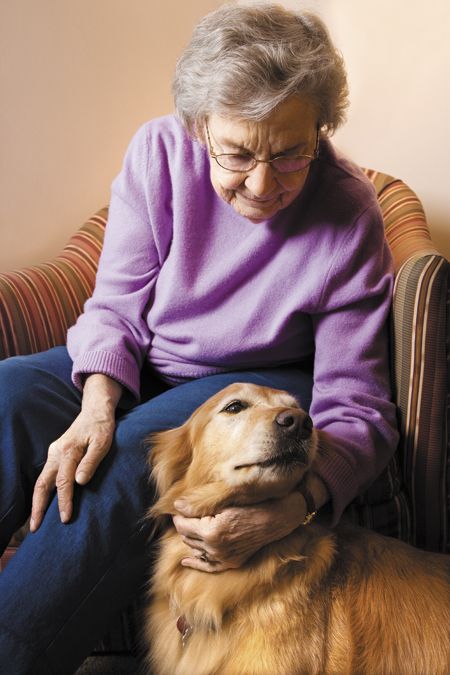Grandmas big secret
You want to help an older client and an aging pet. You dont want to be the subject of a police investigation.

How much can you trust clients? And how responsible are you for what happens to medications and medical supplies after they've left your hospital? (Photo Getty Images)As a rule, golden retrievers don't age gracefully, and Frosty, age 13, was no exception. He was dealing with progressive chronic renal failure, painful arthritis and-for lack of a better term-older-age lumps and bumps. Also true to his breed, Frosty was one of the nicest dogs in the world and truly loved by his owner, Mrs. Rand.
Oscar Rey, DVM, had cared for Frosty since he was a pup. Mrs. Rand was dedicated to her dog and always did what she could reasonably afford to assist this gentle retriever. When he'd been young she couldn't afford a hip replacement for her dysplastic pet, but she used some nonsurgical options: at-home hip massages as well as glucosamine and omega-3 fatty acid supplements. She and Dr. Rey worked as a team to keep Frosty as comfortable as possible.
Now Frosty was starting to lose ground. His BUN and creatinine concentrations were starting to rise, his appetite and weight were decreasing, and his arthritis was getting worse. Mrs. Rand knew his days were dwindling, but she wanted to do everything possible to make him comfortable at home.
She asked Dr. Rey if he could make weekly house calls to evaluate and assist Frosty with his pain. He said he couldn't, but he did offer to create a protocol for Mrs. Rand that would involve some injections. Dr. Rey said he could explain it all in a short instruction session at his clinic.
Dr. Rey proceeded to make up Frosty's at-home care package: two bags of fluids with drip sets, needles for subcutaneous fluid administration, prefilled syringes of Adequan, and tramadol for pain. Dr. Rey told Mrs. Rand to call him with any questions and made it clear that these steps weren't a cure-just a way to make Frosty's final days more comfortable.
The doting Mrs. Rand went home to assist her beloved pet. Eight days later, a police officer stopped at the clinic to see Dr. Rey.
A young man was stopped in a car carrying several other teens, a bottle of tramadol tabs and some needles ...
It seems that a young man had been stopped in a car carrying several other teens, a bottle of tramadol tabs and some needles, all of which the police traced back to Dr. Rey. Some quick research showed that the drugs were part of the home care package Dr. Rey had dispensed to Mrs. Rand. The police officer said the young man was Mrs. Rand's grandson.
It was clear to the authorities what had happened, but they were still required to communicate the incident to the state controlled-substance regulatory agency. The agency didn't sanction Dr. Rey but did complete an audit of the practice's controlled-substance logs and storage procedures.
Dr. Rey called Mrs. Rand and told her what had occurred. She didn't know anything about the incident, she told him, and suggested he might be mistaken. She also said she thought Frosty's home treatment was helping.
Dr. Rey thought the grandson was pulling the wool over Mrs. Rand's eyes, and he was upset that his name and reputation had been put at risk by a negligent client. In the future, he decided, he would think long and hard before sending home medications that could put him in harm's way.
Where, in fact, does the fault lie in this scenario? Should the doctor have assessed not only the patient but also Mrs. Rand's home life? Does a doctor share in a pet owner's irresponsibility?
Rosenberg's response
Pet owners, in consultation with their veterinarians, choose to treat their pets at home for lots of reasons, but needles and controlled substances cannot be dispensed in a vacuum. Clinicians should make a tactful, professional inquiry into the home environment into which controlled substances are being sent. It's easy to say the client's irresponsible behavior isn't the veterinarian's concern, but drug abuse-both legal and illegal-continues to be a challenge in our communities.
I believe that if Dr. Rey had truly wanted to help Mrs. Rand and Frosty, he should have provided some level of supervision and made an attempt to gain insight into the destination of the medications. Dr. Rey had the option to script all his medications through an outside pharmacy or suggest that Mrs. Rand use a house call veterinarian. Because he did not, I feel he should have made reasonably certain that the needles and controlled drugs leaving his clinic would be used and not abused. It's not a lot to ask, and in the end, the community of both pets and people benefit.
Dr. Marc Rosenberg is director of the Voorhees Veterinary Center in Voorhees, New Jersey. Although many of his scenarios in “The Dilemma” are based on real-life events, the veterinary practices, doctors and employees described are fictional.